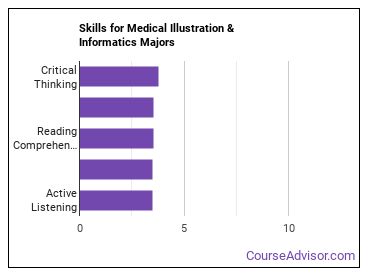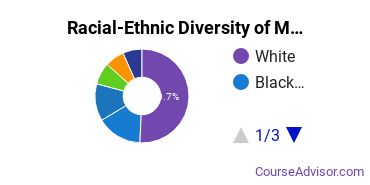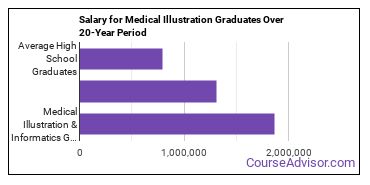Medical Illustration & Informatics
Featured schools near , edit
Types of Degrees Medical Illustration & Informatics Majors Are Getting
The following table lists how many medical illustration and informatics graduations there were in 2020-2021 for each degree level.
| Education Level | Number of Grads |
|---|---|
| Master’s Degree | 1,507 |
| Bachelor’s Degree | 211 |
| Graduate Certificate | 167 |
| Basic Certificate | 84 |
| Doctor’s Degree | 73 |
| Associate Degree | 43 |
| Undergraduate Certificate | 4 |
What Medical Illustration & Informatics Majors Need to Know
People with careers related to medical illustration were asked what knowledge areas, skills, and abilities were important for their jobs. They weighted these areas on a scale of 1 to 5 with 5 being the highest.
Knowledge Areas for Medical Illustration Majors
Medical Illustration majors often go into careers in which the following knowledge areas are important:

- Computers and Electronics - Knowledge of circuit boards, processors, chips, electronic equipment, and computer hardware and software, including applications and programming.
- English Language - Knowledge of the structure and content of the English language including the meaning and spelling of words, rules of composition, and grammar.
- Mathematics - Knowledge of arithmetic, algebra, geometry, calculus, statistics, and their applications.
- Engineering and Technology - Knowledge of the practical application of engineering science and technology. This includes applying principles, techniques, procedures, and equipment to the design and production of various goods and services.
- Design - Knowledge of design techniques, tools, and principles involved in production of precision technical plans, blueprints, drawings, and models.
Skills for Medical Illustration Majors
The following list of skills has been highlighted as some of the most essential for careers related to medical illustration:

- Critical Thinking - Using logic and reasoning to identify the strengths and weaknesses of alternative solutions, conclusions or approaches to problems.
- Judgment and Decision Making - Considering the relative costs and benefits of potential actions to choose the most appropriate one.
- Reading Comprehension - Understanding written sentences and paragraphs in work related documents.
- Complex Problem Solving - Identifying complex problems and reviewing related information to develop and evaluate options and implement solutions.
- Active Listening - Giving full attention to what other people are saying, taking time to understand the points being made, asking questions as appropriate, and not interrupting at inappropriate times.
Abilities for Medical Illustration Majors
Some of the most crucial abilities to master while a medical illustration student include the following:

- Deductive Reasoning - The ability to apply general rules to specific problems to produce answers that make sense.
- Inductive Reasoning - The ability to combine pieces of information to form general rules or conclusions (includes finding a relationship among seemingly unrelated events).
- Written Comprehension - The ability to read and understand information and ideas presented in writing.
- Information Ordering - The ability to arrange things or actions in a certain order or pattern according to a specific rule or set of rules (e.g., patterns of numbers, letters, words, pictures, mathematical operations).
- Oral Comprehension - The ability to listen to and understand information and ideas presented through spoken words and sentences.
What Can You Do With a Medical Illustration & Informatics Major?
Below is a list of occupations associated with medical illustration:
| Job Title | Job Growth Rate | Median Salary |
|---|---|---|
| Business Intelligence Analysts | 9.3% | $90,270 |
| Computer and Information Research Scientists | 19.0% | $118,370 |
| Data Warehousing Specialists | 9.3% | $90,270 |
| Database Architects | 9.3% | $90,270 |
| Fine Artists, Including Painters, Sculptors, and Illustrators | 6.8% | $49,380 |
| Software Developers, Applications | 30.7% | $103,620 |
Who Is Getting a Bachelor’s Degree in Medical Illustration & Informatics?
Racial-Ethnic Diversity
At the countrywide level, the racial-ethnic distribution of medical illustration majors is as follows:

| Race/Ethnicity | Number of Grads |
|---|---|
| Asian | 27 |
| Black or African American | 33 |
| Hispanic or Latino | 14 |
| White | 107 |
| International Students | 14 |
| Other Races/Ethnicities | 16 |
Geographic Diversity
Americans aren’t the only ones with an interest in Medical Illustration. About 6.6% of those with this major are international students. The most popular countries for students from outside the country are:
- India
- China
- Saudi Arabia
- Nigeria
- Nepal
How Much Do Medical Illustration & Informatics Majors Make?
Bachelor’s Degree Starting Salary
The median starting salary of students who graduated in 2017-2019 with a bachelor’s degree in medical illustration was $46,042 per year. These stats come from the U.S. Department of Education. During this timeframe, most salaries fell between $36,905 (25th percentile) and $56,055 (75th percentile).

We don’t know for sure if all of these people took jobs related to medical illustration so take that into consideration.
Salaries According to BLS
Medical Illustration majors often go into careers where salaries can range from $58,370 to $108,080 (25th to 75th percentile). This range includes all degree levels, so you may expect those with a more advanced degree to make more while those with less advanced degrees will typically make less.
To put that into context, according to BLS data from the first quarter of 2020, the typical high school graduate makes between $30,000 and $57,900 a year (25th through 75th percentile). The average person with a bachelor’s degree (any field) makes between $45,600 and $99,000. Advanced degree holders make the most with salaries between $55,600 and $125,400.
Amount of Education Required for Careers Related to Medical Illustration & Informatics
Some degrees associated with medical illustration may require an advanced degree, while others may not even require a bachelor’s in the field. In general, the more advanced your degree the more career options will open up to you. However, there is significant time and money that needs to be invested into your education so weigh the pros and cons.
How much schooling do you really need to compete in today’s job market? People currently working in careers related to medical illustration have obtained the following education levels.

| Education Level | Percentage of Workers |
|---|---|
| High School Diploma - or the equivalent (for example, GED) | 4.3% |
| Post-Secondary Certificate - awarded for training completed after high school (for example, in agriculture or natural resources, computer services, personal or culinary services, engineering technologies, healthcare, construction trades, mechanic and repair technologies, or precision production) | 1.1% |
| Some College Courses | 7.3% |
| Associate’s Degree (or other 2-year degree) | 2.2% |
| Bachelor’s Degree | 60.9% |
| Post-Baccalaureate Certificate - awarded for completion of an organized program of study; designed for people who have completed a Baccalaureate degree but do not meet the requirements of academic degrees carrying the title of Master. | 1.5% |
| Master’s Degree | 17.9% |
| First Professional Degree - awarded for completion of a program that: requires at least 2 years of college work before entrance into the program, includes a total of at least 6 academic years of work to complete, and provides all remaining academic requirements to begin practice in a profession. | 0.3% |
| Doctoral Degree | 4.2% |
| Post-Doctoral Training | 0.5% |
Online Medical Illustration & Informatics Programs
In 2020-2021, 167 schools offered a medical illustration program of some type. The following table lists the number of programs by degree level, along with how many schools offered online courses in the field.
| Degree Level | Colleges Offering Programs | Colleges Offering Online Classes |
|---|---|---|
| Certificate (Less Than 1 Year) | 0 | 0 |
| Certificate (1-2 years) | 6 | 0 |
| Certificate (2-4 Years) | 0 | 0 |
| Associate’s Degree | 16 | 2 |
| Bachelor’s Degree | 49 | 19 |
| Post-Baccalaureate | 0 | 0 |
| Master’s Degree | 101 | 39 |
| Post-Master’s | 18 | 0 |
| Doctor’s Degree (Research) | 20 | 2 |
| Doctor’s Degree (Professional Practice) | 1 | 1 |
| Doctor’s Degree (Other) | 0 | 0 |
Is a Degree in Medical Illustration & Informatics Worth It?
The median salary for a medical illustration grad is $93,350 per year. This is based on the weighted average of the most common careers associated with the major.
This is 134% more than the average salary for an individual holding a high school degree. This adds up to a gain of about $1,069,000 after 20 years!

Top Ranking Lists for Medical Illustration & Informatics
Explore Major by State
Alabama
California
District of Columbia
Idaho
Kansas
Maryland
Mississippi
Nevada
New York
Oklahoma
South Carolina
Utah
West Virginia
Alaska
Colorado
Florida
Illinois
Kentucky
Massachusetts
Missouri
New Hampshire
North Carolina
Oregon
South Dakota
Vermont
Wisconsin
Majors Related to Medical Illustration & Informatics
You may also be interested in one of the following majors related to medical illustration.
References
*The racial-ethnic minorities count is calculated by taking the total number of students and subtracting white students, international students, and students whose race/ethnicity was unknown. This number is then divided by the total number of students at the school to obtain the racial-ethnic minorities percentage.
- College Factual
- College Scorecard
- National Center for Education Statistics
- O*NET Online
- U.S. Bureau of Labor Statistics
- Usual Weekly Earnings of Wage and Salary Workers First Quarter 2020
More about our data sources and methodologies.
Featured Schools
 Request Info
Request Info
|
Southern New Hampshire University You have goals. Southern New Hampshire University can help you get there. Whether you need a bachelor's degree to get into a career or want a master's degree to move up in your current career, SNHU has an online program for you. Find your degree from over 200 online programs. Learn More > |

